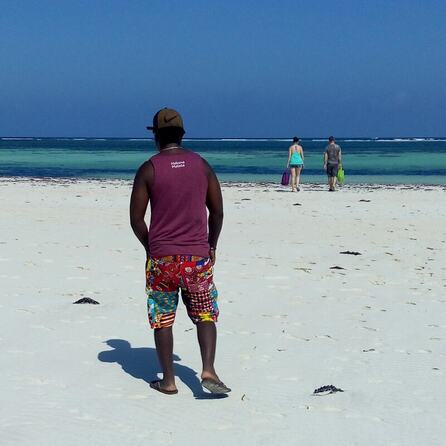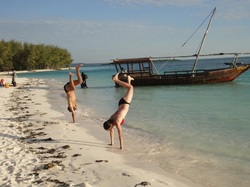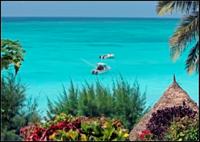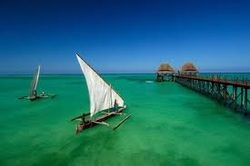Zanzibar
Kili Wild Expedition Adventures Experts
BEACH HOLIDAYS:

Beach Holidays in Tanzania
Tanzania is blessed with coastline of 1,424 km of which over 500 miles is pure white sandy and unspoiled beaches, all lapped by the warm waters of the Indian Ocean. The culturally and historically significant islands of Zanzibar and Mafia are incredible destinations in themselves. Tanzania boasts the second largest freshwater body in world in Lake Victoria, the second deepest in Lake Tanganyika as well as Lake Nyasa / Malawi. If you love beach life then Tanzania really possesses a multitude of options for you to enjoy.

Zanzibar
Today it combines ancient Islamic ruins, noble Arabic houses with miles of white sandy palm fringed beaches and coves.The ocean offers warm clear blue waters, idyllic islands excellent reefs for snorkeling and diving, fantastic deep sea fishing, water sports and of course delicious fresh fish. You can also opt to go for an early morning dhow cruise. The island is surrounded by pristine beaches and we’d be happy to show you the one that would suit you best. The Spice island of Zanzibar lies off the coast of Tanzania in the Indian Ocean. It is famous for once being the commercial centre of East Africa and the last place to abolish the slave trade. Unguja (popularly known as Zanzibar) The Ugunja Island stretches about 95 kms from north to south and is located 35 kms from the mainland Tanzania. Few countries in the world can equal Zanzibar’s long fine white sand beaches, which lead into warm aquamarine waters and provide the back drop for excellent diving and snorkelling. It is these qualities among others, that make the island one of the most popular tourist destinations worldwide. Stone Town Tour (also called Unguja Town or Zanzibar town) In Stone Town, every corner you turn offers a new, exotic scent. The Stone Town was declared a UNESCO World Heritage Site in 2,000 and was praised by UNESCO as “an outstanding material manifestation of cultural fusion and harmonization”. If you choose to explore the Stone Town, here are some of the attractions you will see. Stone Town Cultural Centre
This is a grand four-storey building found near the sea front along Mzingani road. It was originally built as a private residence, but was later used as a dispensary during colonial time
Darajani Market
It is a lively place to visit even if just to look around. It is located near the bus station along Greek road
Great Slave Market
The present Anglican Cathedral Courtyard was previously a home to the Great Slave Market for the whole of East Africa, and the source of Zanzibar’s commercial success during the 19th century. At its peak, up to 60,000 slaves passed through the market each year. The Anglican Missionary Hospital is constructed on top of the old slave chambers. Tours are available for both, the slave chambers and the cathedral.
Livingstone’s House
It was built around 1,860 for Sultan Majid and was used by many missioneries and explorers as a starting point.
National Museum (or House of Peace)
This is a small domed-building with a lovely garden. It includes sections on orchaeology, early trade and ships, slavery, palaces, mosques, sultans explorers, clove oil production, traditional crafts and household items, among others
Palace Museum
This is a large white building that was formerly the official residence of the Sultan of Zanzibar. Visitors to the museum can see much of the Sultan’s furniture and other possessions that survived the revolution.
House of Wonder
This is a large square-shaped building that dominates the skyline of Stone Town. Outside the building are three canons that date back to Portuguese times.
Arab Fort
Built between 1698 and 1701, the Fort is situated next to the House of Wonders. The Fort is open to visitors and now contains shops, a café and an open-air theatre
Dhow Harbour
It lies fifty meters inside the port gates, featuring traditional dhows and a lively wharf.
Jamhuri Gardens
These gardens feature a nightly market where fresh sea food, kebabs, sugarcane juice and ice cream are sold.

Mafia Island
With idyllic setting and tranquil milieu, the island of Mafia, once an important trading center between the 11th and 13th centuries, now draws tourists to it’s extraordinary coral formations and marine park. The waters of the island are splendid for swimming, snorkeling, scuba diving,sailing and sport fishing.

Pangani
The name Pangani owes to the river that runs through northern part of this Historical Town. Pangani is an ancient town, and is believed to have been established before the 6th Century BC and played an important role during the slave trade era. It was a trading port dealing mainly with slaves and ivory. Several historical sites in and around the town serve as reminders for the strong Arabic influence and the later German, British colonial era in Tanganyika. Nowadays it is mainly a fishing town dotted with coconut trees, providing beautiful beaches for quiet vacation. Pangani is situated about 50km south of Tanga on the mouth of River Pangani that flows from the slopes of Mt. Kilimanjaro.

Bagamoyo
The sleepy atmosphere of Bagamoyo hides a history of prosperity, wealth and wonderful tales, but also sufferings and tragedy. In a way, all this is expressed in the name Bagamoyo, which means something like “lay down the burden of your heart” or “be quiet my heart”. This can both be interpreted as the forlorn cry of the slaves leaving their home country and the exclamation of the relived caravan porters reaching their destination. Bagamoyo gained its name in the caravan days when the streets where dense with people and merchandise. Then it was only possible to move in the streets with difficulty and now and then caravan porters tripled the town population. Ships from distant ports where a common sight in the harbour and the shops were filled with exotic goods. Today Bagamoyo offers a wealth of historical attractions and some of the most wonderful beaches in East Africa.
